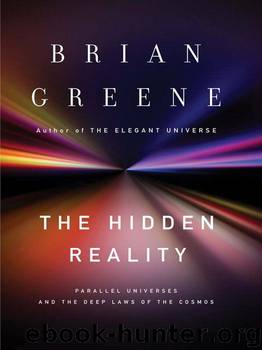The Hidden Reality: Parallel Universes and the Deep Laws of the Cosmos by Greene Brian

Author:Greene, Brian [Greene, Brian]
Language: eng
Format: mobi, epub
Publisher: Knopf
Published: 2011-01-24T16:00:00+00:00
Mysteries and Multiverses:
Can a multiverse provide explanatory power of which we’d otherwise be deprived?
No doubt you’ve noticed that even the most sanguine projections suggest that predictions emerging from a multiverse framework will have a different character from those we traditionally expect from physics. The precession of the perihelion of Mercury, the magnetic dipole moment of the electron, the energy released when a nucleus of uranium splits into barium and krypton: these are predictions. They result from detailed mathematical calculations based on solid physical theory and produce precise, testable numbers. And the numbers have been verified experimentally. For example, calculations establish that the electron’s magnetic moment is 2.0023193043628; measurements reveal it to be 2.0023193043622. Within the tiny margins of error inherent to each, experiment thus confirms theory to better than 1 part in 10 billion.
From where we now stand, it seems that multiverse predictions will never reach this standard of precision. In the most refined scenarios, we might be able to predict that it’s “highly likely” that the cosmological constant, or the strength of the electromagnetic force, or the mass of the up-quark lies within some range of values. But to do better, we’ll need extraordinarily good fortune. In addition to solving the measure problem, we’ll need to discover a convincing multiverse theory with profoundly skewed probabilities (such as a 99.9999 percent probability that an observer will find himself in a universe with a cosmological constant equal to the value we measure) or astonishingly tight correlations (such as that electrons exist only in universes with a cosmological constant equal to 10–123). If a multiverse proposal doesn’t have such favorable features, it will lack the precision that for so long has distinguished physics from other disciplines. To some researchers, that’s an unacceptable price to pay.
For quite a while, I took that position too, but my view has gradually shifted. Like every other physicist, I prefer sharp, precise, and unequivocal predictions. But I and many others have come to realize that although some fundamental features of the universe are suited for such precise mathematical predictions, others are not—or, at the very least, it’s logically possible that there may be features that stand beyond precise prediction. From the mid-1980s, when I was a young graduate student working on string theory, there was broad expectation that the theory would one day explain the values of particle masses, force strengths, the number of spatial dimensions, and just about every other fundamental physical feature. I remain hopeful that this is a goal we will one day reach. But I also recognize that it is a tall order for a theory’s equations to churn away and produce a number like the electron’s mass (.000000000000000000000091095 in units of the Planck mass) or the top quark’s mass (.0000000000000000632, in units of the Planck mass). And when it comes to the cosmological constant, the challenge appears herculean. A calculation that after pages of manipulations and megawatts of computer-crunching results in the very number that highlights the first paragraph of Chapter 6—well, it’s not impossible but it does strain even the optimist’s optimism.
Download
The Hidden Reality: Parallel Universes and the Deep Laws of the Cosmos by Greene Brian.epub
This site does not store any files on its server. We only index and link to content provided by other sites. Please contact the content providers to delete copyright contents if any and email us, we'll remove relevant links or contents immediately.
The Complete Stick Figure Physics Tutorials by Allen Sarah(7307)
Secrets of Antigravity Propulsion: Tesla, UFOs, and Classified Aerospace Technology by Ph.D. Paul A. Laviolette(5309)
Thing Explainer by Randall Munroe(3877)
The River of Consciousness by Oliver Sacks(3541)
The Order of Time by Carlo Rovelli(3145)
How To by Randall Munroe(3035)
A Brief History of Time by Stephen Hawking(2962)
I Live in the Future & Here's How It Works by Nick Bilton(2936)
The Great Unknown by Marcus du Sautoy(2648)
What If?: Serious Scientific Answers to Absurd Hypothetical Questions by Randall Munroe(2637)
Midnight in Chernobyl by Adam Higginbotham(2483)
Blockchain: Ultimate Step By Step Guide To Understanding Blockchain Technology, Bitcoin Creation, and the future of Money (Novice to Expert) by Keizer Söze(2449)
Networks: An Introduction by Newman Mark(2360)
The Meaning of it All by Richard Feynman(2300)
Easy Electronics by Charles Platt(2282)
The Tao of Physics by Fritjof Capra(2231)
Midnight in Chernobyl: The Untold Story of the World's Greatest Nuclear Disaster by Adam Higginbotham(2177)
When by Daniel H Pink(2083)
Introducing Relativity by Bruce Bassett(2080)
